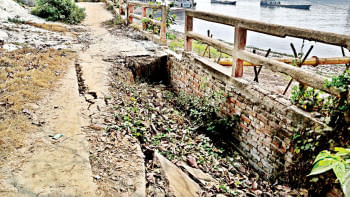Gopalganj cannot become a symbol of fear and injustice

It is distressing to learn that fear still grips many in Gopalganj due to ongoing police drives, with 322 people arrested so far—many of whom have since been released—and over 8,400 accused in eight cases filed over the deadly violence during last Wednesday's clashes. On Monday, our correspondent visited several villages in Tungipara, Gopalganj. While the last few days have seen things return to some semblance of normalcy, locals still expressed scepticism amid continuous patrols and raids. Some reported experiencing blackouts during night-time raids. Many, accused or not, especially men with suspected Awami League ties, remain at large fearing arrests. Some families have taken shelter in the houses of relatives or local leaders. This situation has obviously created security risks for vacated houses or families unattended by male adults, as well as threats of legal harassment.
These fears are real even though the authorities have dismissed allegations of mass arrests and exploitative litigation. Already, the number of inmates in Gopalganj District Jail has surged in recent days. Although the prison has a capacity of 360, it is currently holding 865 inmatess—far above the usual average of 600—not to mention the dozens transferred to the neighbouring Pirojpur district jail due to space constraints. The protracted security fallout is but an indication of the government's poor handling of the Gopalganj situation from the start, which reached an extent that even the families of victims were reportedly reluctant to file cases, fearing they would not get justice. Another indication, no less significant, is its failure or inability to perform autopsies on time, which can help determine who or what was responsible for the killings. It was only on Monday, five days after burial, that the bodies of three of the five killed were exhumed for post-mortem examinations, that too following a court order.
The evolving details of this saga that unfolded after Awami League supporters' attack on a planned NCP rally are well known by now. There is no denying that prolonged tension in Gopalganj will only negatively affect other parts of the country. State officials, try as they may, cannot abdicate themselves from the responsibility for the so-called "arrest trade" or "litigation trade", a natural outcome when the rule of law is compromised. More importantly, they must understand that the image they had created of themselves by initially allowing four victims to be laid to rest without any inquest or post-mortem examination raises unsettling questions about their capability and sincerity. These questions must be answered and addressed through an impartial investigation.
Going forward, any arbitrary arrest and intimidation—rights violations more easily associated with the fallen regime—must be ceased. The government should instead focus on fully restoring peace in Gopalganj and holding to account not just the perpetrators of July 16 violence but also those who failed to prevent it or acted irresponsibly in its aftermath.


 For all latest news, follow The Daily Star's Google News channel.
For all latest news, follow The Daily Star's Google News channel. 









Comments